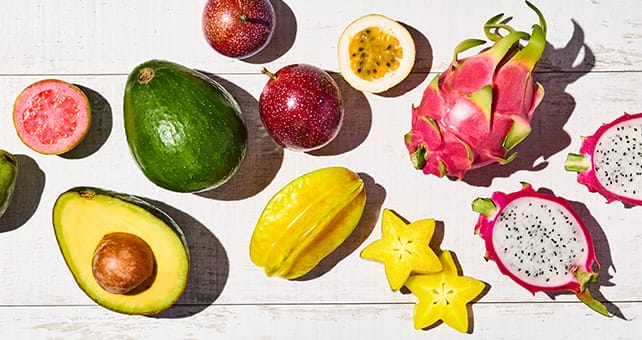The tropics are calling.
Imagine Florida’s sparkling emerald seas. Gentle waves lapping at soft white sand. Tall palm trees waving just beyond the dunes. Beautiful, lush greenery reaching into the wilds of Florida. And there, amid it all, grow our intriguing and delightful tropical fruits.
These delicious fruits reach peak season about the same time the Florida sun reaches its warmest temperatures: July and August. Look for these brightly colored, distinctively shaped fruits in our stores throughout the summer and be sure to explore the variety. You’ll taste the Florida tropics in every marvelous bite.
Meet our tropical superstars.
Get to know our tropical fruits and find out a few ways we enjoy them.
Carambola
Better known as star fruit, this tasty little fruit can be eaten sliced or whole (just like you’d eat an apple), but we love serving it sliced to show off those pretty stars. It’s perfect for dressing up an otherwise ordinary fruit salad. Give it a try in our Sparkling Honeydew–Star Fruit Salad.
Dragon Fruit
This peculiar-looking fruit might not breathe fire, but it’s intriguing all the same. Also known as pitaya and a member of the cactus family, dragon fruit can be sliced right down the center and enjoyed on its own, in smoothies, or in fresh juices. Looking for starter recipes? Try our Dragon Fruit Breakfast Crêpes or Dragon Fruit Ice Pops.
Florida Avocado
The Florida avocado grows three to four times larger than the Hass avocado, and its skin stays green rather than turning black. When the skin yields to gentle pressure, it’s ready to eat. We love it in our Pan-Fried Avocado Fries.
Guava
This Florida gem is a lot more than just pretty in pink. It’s a favorite for sweet dishes like pastries or as jelly atop a slice of toast. It’s sweetest when it’s soft and is only ripe for a couple days. Enjoy it on its own or get adventurous with our Coconut-Guava Freeze.
Passion Fruit
This spirited little fruit is a favorite in Hispanic cultures and is commonly used for fruit juices. To enjoy the sweet-tart pulp inside, wait until the fruit wrinkles to cut it. That’s when it’s ripe! You’ll find it easiest to cut with a sharp, serrated knife. Simply cut it across the middle, scoop out the pulp, and enjoy.

 You are about to leave publix.com and enter the Instacart site that they operate and control. Publix’s delivery and curbside pickup item prices are higher than item prices in physical store locations. Prices are based on data collected in store and are subject to delays and errors. Fees, tips & taxes may apply. Subject to terms & availability. Publix Liquors orders cannot be combined with grocery delivery. Drink Responsibly. Be 21. For prescription delivery, log in to your pharmacy account by using the Publix Pharmacy app or visiting
You are about to leave publix.com and enter the Instacart site that they operate and control. Publix’s delivery and curbside pickup item prices are higher than item prices in physical store locations. Prices are based on data collected in store and are subject to delays and errors. Fees, tips & taxes may apply. Subject to terms & availability. Publix Liquors orders cannot be combined with grocery delivery. Drink Responsibly. Be 21. For prescription delivery, log in to your pharmacy account by using the Publix Pharmacy app or visiting 